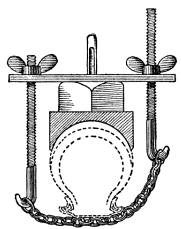Difference between revisions of "Vulcanizer"
(Created page with '==Home-Made Vulcanizer== ''From: Popular Mechanics 1911, feb'' Image:vulcanizer_pop_mech.png A novel vulcanizer for pneumatic tires, and one that will do exellent work, can …') |
m |
||
| Line 2: | Line 2: | ||
''From: Popular Mechanics 1911, feb'' | ''From: Popular Mechanics 1911, feb'' | ||
| − | [[Image:vulcanizer_pop_mech.png]] | + | [[Image:vulcanizer_pop_mech.png|right]] |
A novel vulcanizer for pneumatic tires, and one that will do exellent work, can be made of an old electric smoothing iron. The handle is removed and a 1/4 inch hole drilled in the top, 1 3/4 inch deep, for a small thermometer registering high temperatures. A small wood pattern is made flat on one side, and cut out to fit the tread of the tire on the other, and used in making a mold for a brass casting. A piece of woo is formed to fit inside the shoe. | A novel vulcanizer for pneumatic tires, and one that will do exellent work, can be made of an old electric smoothing iron. The handle is removed and a 1/4 inch hole drilled in the top, 1 3/4 inch deep, for a small thermometer registering high temperatures. A small wood pattern is made flat on one side, and cut out to fit the tread of the tire on the other, and used in making a mold for a brass casting. A piece of woo is formed to fit inside the shoe. | ||
Latest revision as of 19:37, 19 June 2010
Home-Made Vulcanizer
From: Popular Mechanics 1911, feb
A novel vulcanizer for pneumatic tires, and one that will do exellent work, can be made of an old electric smoothing iron. The handle is removed and a 1/4 inch hole drilled in the top, 1 3/4 inch deep, for a small thermometer registering high temperatures. A small wood pattern is made flat on one side, and cut out to fit the tread of the tire on the other, and used in making a mold for a brass casting. A piece of woo is formed to fit inside the shoe.
Two rods of wrought 1/4 inch in diameter by 6 inches long, are each threaded on one end for a distance of 3 inches. The other end of each of these rods is formed into a hook to hold a piece of chain. The sketch clearly shows the apparatus, also the method of clamping it to an automobile tire. It is only necessary to connect the iron by a flexible electric cord to a lamp socket in the ordinary way, the current being preferably turned on at the iron and not by the socket switch.
